return to 2004 The Ten Biggest Phonies
Living Today
by Jasper Johns
Stain not our pure vales with thy guilty blood! —Byron
When I am busy painting or sculpting I haven't always the time to devote to this column that I would like. In those cases I know I can count on ARTnews or one of the other not-so-cheapsheets to come up with my material for me. All I need to do is read a headline, look at a couple of silly pictures: my inspiration is upon me and before you can say "art is dead" my column is finished, edited by the Muses as I go.
Meaning that this week's title came from changing a few words in ARTnews' cover article [May 2004] "The Ten Most Expensive Living Artists." That article is part of a Special Money Issue—which seems redundant in that every issue of ARTnews is a money issue. If the artists profiled weren't obscenely rich there would be no reason to profile them. For years the ads in all the avant garde magazines had only the name of the artist and the name of the gallery—no picture of the work was necessary since the work was superfluous. It could be anything or nothing, and usually was. We now see more ads with photos, but I tend to think the old way was more consistent as theory and more sensible as advertising—although the new ads do continue to prove that the work is superfluous.
But a Special Money Issue is obviously a giveaway to the senses and sensibilities of the editors and readers of the magazine... so much so that I am going to pass it by as OLDnews. If these poor people want to bare their shrivelled souls every month, why should I continue to throw water upon them, hoping they will grow? They must feel, as Jane Austen said, "For what do we live, but to make sport for our neighbours?" And such fine and cunning sport they do make for those of us with both eyes and souls unshrivelled.
Before I begin shooting in earnest however, I would like to answer a few pacifistic allies who have complained of my tone. They feel that art is the highroad, argumentation the lowroad. Any response is therefore stooping to the level of the enemy. In answer, I can only say that my view of warfare is just as unmodern as my view of art. My preferred analogy is the Cheyenne brave, who knows that the most efficient short-term method in warfare is an arrow to the neck. But the most generous, the most satisfying, and at the same time the most awe-inspiring method is "taking coup". That is, riding past the misaimed arrows of the enemy to strike him lightly with a curved stick, showing him his inferiority at shooting, and your superiority at bravery, horsemanship, and luck. If he has a speck of intelligence he will see that any future skirmish would be fatal, and he and his fellows will slink off to the nearest dark cave. Not only that, but they will tell the others they meet of your prowess, and you will likely never have to fight again. That is efficiency in the long term. Counter-criticism is taking coup.
Now back to the Biggest Phonies. Jasper Johns wins the top prize—40 million for Gray Numbers, stencilled numbers painted gray and brown. An absolutely pointless work that no one could possibly find interesting in itself. You could listen to a long-winded explanation of how it ties into modern theory, but if you did I would have to touch you with my curved stick and send you to the cave. There you would find the owner of the work, David Geffen, whom you might fear would tell you the same long story. But he wouldn't. No, he is at least clever enough to know how boring that story is. He would tell you a very short story about how much the gray numbers cost, and how he could afford it, so no big deal, and hey you look nice today, have been working out, would you like to be in a movie? In the cave would also be Jasper himself, and he and David would call upon you to officiate in their Indian leg-wrestling contest to decide who got the most phony glory for Gray Numbers.
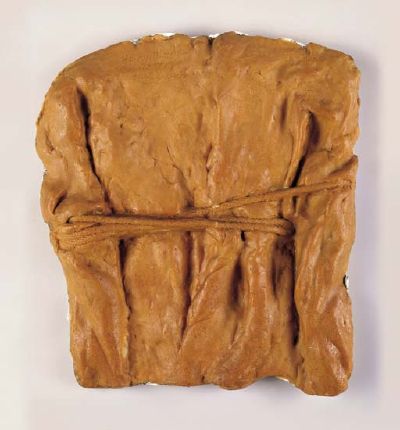
Bruce Nauman also gets his picture in the magazine again for doing nothing. He is at or near number 2, although I never would have guessed it. This time he is on a horse with a lasso (I assume it is a real horse—it may be a prop). He is clearly at pains to give the impression that he is on some vast expensive/expansive Montana ranch, abutting the ranch of Harrison Ford perhaps, where he and Han Solo will rustle up some dogies before rushing back to the tent for a can of beans and a quick masterpiece or two. His work Henry Moore Bound to Fail appears to be a rubber mold of a longsleeve shirt with a rope around it, painted orange. Do not ask what in tarnation this has to do with Henry Moore, since that might imply you cared. Also do not ask how it can be worth 10 million to anyone, or you may be told that the rope is really a lasso, and can't you see the multiple meanings, and so on and on.
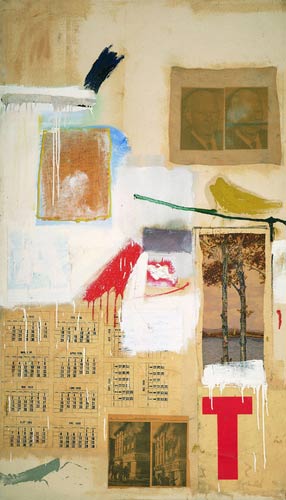
Robert Rauschenberg makes the list, of course, for Factum II. It is a collage of three or four old photographs, a calendar, some stencilling and some white paint, which MOMA paid 12 million for. Bob was clearly trying to create a greater creative abyss, a painting even more devoid of any last trace of skill, intent, content, meaning, or value, than Johns' Gray Numbers. I would have to call it a tie.
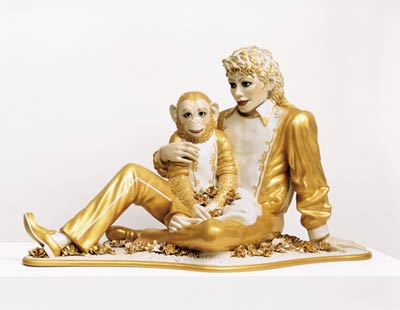
Jeff Koons appears courtesy Michael Jackson and Bubbles, his most famous and expensive work (5.6 million). It is a gold and white, high-detail statuette of MJ and his monkey. The awfulness of the work is supreme, and I feel like sending someone a bill for 5.6 million for subjecting my eyes to it. I am truly amazed that artists like Koons can allow themselves to be seen in public, much less have their picture taken as proof to the gods. I seriously recommend lightning insurance.
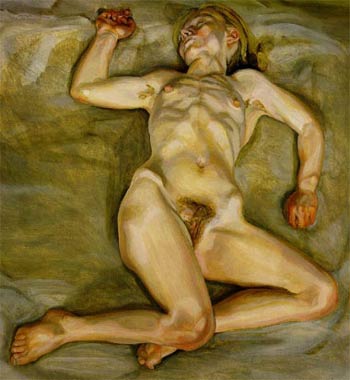
Then of course we have Lucian Freud and one of his grisly monstrosities—it reminds me of Sargent's joke title for a little watercolor: Troglodites of the Cordilleras. If Freud hadn't become one of the ten biggest phonies he might have done some useful work on the sets of Dawn of the Dead and all the sequels.
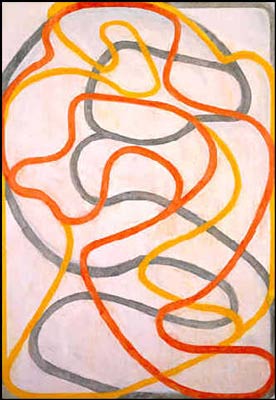
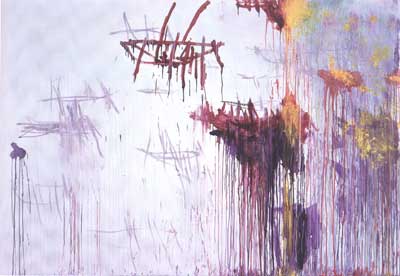
Brice Marden painted some squiggles and got famous, no one understands how, and so did Cy Twombly—although Cy forgot to lay his canvas on the ground like Pollock taught the squiggly guys, so we get those delicious drips, full of latent meaning and longing and whatnot. Frank Stella painted something—no one knows what it is, but it is titled Bethlehem's Hospital so it must be full of deep religious intent.

The latest member of the 10 million club and the biggest phony club is Gerhard Richter, who painted Der Kongress. It looks very much like a Munich 10th grader's bad copy of a Der Spiegel photo. Except that the 10th grader would probably have hit on a more interesting photo to copy, and might have kept the projector still while he was pencilling it in.
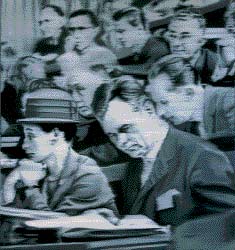
Others who missed the top-ten by a hair: Chuck Close, Claes Oldenburg, Anselm Kiefer, and our-cherished-enemy David Hockney. Soon-to-be contenders: Jenny Saville and John Currin. "Market experts" predict that Currin—now that he is with Gagosian Gallery—will soon see 7 figures, perhaps even for new work.
I have been trying to come up with an historical analogy. Something along the lines of, Someday the 20th century avant garde will take its places with the other historical mysteries and tragedies, the massive frauds, the intellectual fakeries, the various societal illnesses, such as.... But I could come up with nothing. Not the Aztecs, not Alcibiades being called back from Sicily, not the Crusades, not the Hundred Years War. Never have people, as individuals or as governments, spent so much money for so little—literally billions of dollars for absolutely nothing—and not even attempted to justify it with religious or political conviction on a very large scale. The only thing that comes close is the money wasted by 20th century governments on the military, but even there the analogy fails to hold, no matter your political opinion. That is, the US and USSR may or may not have needed all those planes and bombs and ships, but at least the planes flew and the ships floated and the bombs ignited. But a painting by Johns or Rauschenburg was grounded from the beginning. It had the explosive potential of a squib. And it was lauded precisely for this reason. It was meant to be nothing, to exude nothingness, to cause nothing, to do nothing, to stand for nothing. Any modern work's theoretical brilliance was in its artistic nullity, from Duchamp's commode, to Warhol's Brillo Box, to Lichtenstein's cartoons to Richter's photocopies. The critics have confirmed this. The clients and museums have signalled their complicity and approbation. The buyer desired to be given a false bill of goods. And no one required justification from the gods or from any other great overriding principles. The avant garde may play with political theorizing, but David Geffen's purchase of Gray Numbers cannot be justified by any religious or political argument. He bought it solely because it was expensive and everybody knows that.
Never before has nothing passed for something for so long. People have been duped religiously and politically and financially, in ways that certainly surpass the avant garde in historical importance. But never in history has a worldwide heist taken place in full public view, with a thumb's up from the victim, and continued decade after decade after decade. It would be like Enron investors asking that the scandal become permanent, since it got their names in the papers. If the failing companies only defrauded the richest investors, and promised them their pictures in Vanity Fair and ARTnews for it, we might make Wall Street fraud a permanent legal business. After all, the superrich can afford rigged stock losses just as easily as losses at Sotheby's and Christie's, as long as we give them an equivalent eclat. If it were only paying the right consultants to think for it, Worldcom could begin offering a framed "certificate of loss" to hang in the foyer. Then, instead of pointing to Gray Numbers, David Geffen could point to his framed certificate of loss. It would carry the same ability to impress the same people. They would say to themselves, "David Geffen, very rich guy and moron. Now, I too want to be where morons can make a lot of money, so let's go to David's house and be David's friend." Voila, David gets what he paid for and the end is the same.
And this, you see, is why my curved stick cannot touch David Geffen, or his friends, or the artists he admires. They are all beyond embarrassment. They do not recognize superior bravery or horsemanship or even luck. They prefer life in the cave, where no one does anything at all extraordinary—except sometimes make a lot of money. It is not Atlas that has shrugged, as in Ayn Rand's tale. It is the Nibelungs, Wagner's dwarfs, who have shrugged. They have freed themselves of the tyranny of quality, of the heroics of Siegfried, of the judgment of Wotan, of the works of true artists. They have moved, like Rand's supermen, into a mythical place of their own, they have settled a land far distant from any comparison with real achievement, and, again like Rand's heroes, they have erected the dollar sign at the gate. And in so doing they have not only overturned the hierarchies of the past, they have redefined the "progression" of history. All the class struggles of previous centuries have only empowered the Geffens and Rauschenbergs and Currins, and we might hear, had we the ears for it, the cry "Morons of the world, unite!" Michelangelo himself could return to hurl thunderbolts at them, but they would be beyond his reach. His dissatisfaction would touch them not at all. Their circle is closed. They have what they want. They have money and fame. They do not want, and cannot see, bravery or horsemanship or fine art.
You may ask why I continue to attack them. Why tilt at the silent windmill? Why chastise the Nibelungs for being dwarfs? My words will not make them into heroes, my coup will not unshrivel their tiny souls. I attack because their world is not yet the whole world. The dollar sign is not yet upon the gate that I call home, and I would keep their parties off my lawn. Besides, there are some in the ranks who still recognize superior horsemanship, and who understand even the virtue of luck—for luck is the sign of the hand of the Muse. I would ride into the thickest hail of arrows, were no one left watching but the Muse herself, veiled and beautiful.
If this paper was useful to you in any way, please consider donating a dollar (or more) to the SAVE THE ARTISTS FOUNDATION. This will allow me to continue writing these "unpublishable" things. Don't be confused by paying Melisa Smith--that is just one of my many noms de plume. If you are a Paypal user, there is no fee; so it might be worth your while to become one. Otherwise they will rob us 33 cents for each transaction.